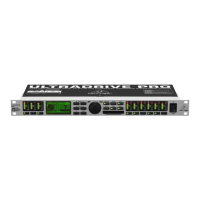17
ULTRADRIVE PRO DCX2496
4.4.1 INPUT/GAIN
Fig. 4.37: Sum ß Input/Gain
In this menu, the parameter IN SELECT allows you to define a
combination of two inputs forming the SUM signal. Available
options are: IN A + IN B, IN A + IN C and IN B + IN C. Of course,
you can also use just one input signal as your SUM signal (IN A,
IN B or IN C), by doubling one of the inputs. It is impossible,
however, to form a SUM signal composed of all input signals!
If no additional source signal is required, set IN SELECT to OFF.
The current SUM configuration is shown graphically below this
parameter.
In the top left corner of the display you can use SUM INPUT
GAINS to adjust the input signal of the inputs A-C. The signal
controlled here is taken directly from post-input convertersnot
post-EQ or post-Dynamics. Therefore, it is not necessary to re-
adjust the input gain. The SUM INPUT GAINS setting range is
from -15 to +15 dB.
With the OUT GAIN parameter you can control the internal output
level of the sum signal. This signal is also taken pre-EQ, pre-
Dynamics, etc. and is then routed to output channels 1-6. The
gain setting also ranges from -15 to +15 dB. Thus, you can use
one parameter to quickly adjust all inputs together in their adjusted
balance at the same time.
The following SUM pages are 100% identical to the
IN A/B/C pages 2/5 to 5/5 (see chapters 4.3.2 to 4.3.5)!
4.5 OUT 1-6 menu
Press one of the OUT 1-6 buttons to enter the OUTPUT menu
of the respective output. Here, you can set the IN-OUT
configuration, X-OVER POINT or, as with the input signals, the
EQ and DYNAMIC EQ parameters.
4.5.1 GENERAL
Fig. 4.38: Out 5 ß General
On the first page of this menu, the parameter INPUT SOURCE
allows you to choose the input signal feeding the selected output.
Available options are the inputs A-C and the additional SUM signal.
If a STEREO-LINK configuration has been previously selected in
the SETUP menu (see chapter 4.2.1. IN/OUT), input A will
automatically be routed to the LEFT CHANNEL outputs, and
input B to the RIGHT CHANNEL outputs. However, these preset
configurations can be edited as desired.
The OUT 1(-6) GAIN parameter controls the volume level of the
respective output channel (also pre-EQ, pre-DYNAMIC EQ, etc.).
The setting range is from -15 to +15 dB. Just as the inputs, the
output levels should be set properly to avoid distortion.
The third parameter, OUT 1-6-NAME can be used to assign
specific names to the outputs. In contrast to the DCX2496 inputs,
you cannot enter single characters here, but you may choose from
a list of preset names (e.g. LEFT LOW-MID, RIGHT HI-MID,
SUBWOOFER etc.). Depending on the output configuration (e.g.
LMHLMH) and the output selected, the system assigns a default
name. This name can be changed at any time by using the data
wheel to select a different name from the list.
Tab. 4.4: Default output names, depending on output
configuration
4.5.2 X-OVER POINTS
On this page, you can define the cutoff frequencies and filter
curves for the individual outputs, which are displayed graphically
for one stereo side and over the entire frequency range. Use the
OUT buttons 1-6 to select the output to be processed. A frame
around the selected OUT number highlights your selection.
Fig. 4.39: Out 5 ß X-Over Points
Use the TYPE parameter in the top left corner of the display to
define the type of curve at the lower (left) slope. To define the
upper (right) slope, use the TYPE parameter in the top right corner
of the display. Both parameters are marked by a curve symbol.
You can choose from three different types of filters:
1. Butterworth (with a slope of either 6, 12, 18, 24 or 48 dB/oct)
2. Bessel (with a slope of either 12 or 24 dB/oct.)
3. Linkwitz-Riley (with a slope of either 12, 24 or 48 dB/oct.)
+ With higher slopes, the number of filters goes down (see
EQ page 3/6, display >FREE<). For each 12 dB increase
in slope, you will lose 1-2 EQs.
The FREQ parameter in the top left corner of the display selects
the lower (left) cutoff frequency for one output. With the same
parameter on the right-hand side you can determine the upper
(right) cutoff frequency. These parameters, too, are marked by a
curve symbol.
The X-OVER ADJUST MODE, when set to FREE, allows you
to enter all TYPE and FREQ values, independent of one another.
When set to LINK, you can couple the X-Over filters of adjacent
outputs. Though your entries are retained, they will be
proportionally shifted with each parameter change. When you shift
the upper cutoff frequency of OUT 1 in the LMHLMH configuration
for test purposes, the lower cutoff frequency of OUT 2 will be shifted
as well.
The following pages 3/8 to 5/8 (EQ, DYNAMIC EQ (FILTER)
and DYNAMIC EQ (DYNAMICS)) are 100% identical to the IN
pages 3/5 to 5/5!
4.5.3 LIMITER
To protect your power amplifiers and loudspeakers, the
ULTRADRIVE PRO DCX2496 features a limiter for each of the
six outputs. Use this device to suppress harmful level peaks.
4. MENU STRUCTURE AND EDITING

